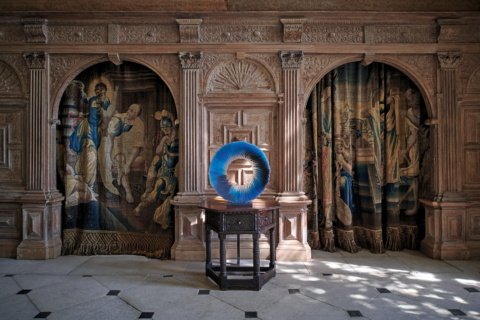Frieze Sculpture Park on Regents Park, London UK. Photo by Linda Nylind. 15/9/2025.
PHOTO: LINDA NYLIND. COURTESY OF FRIEZE.
Frieze Sculpture’s 13th edition takes over Regent’s Park and Season 5 of public art organisation Artichoke Trust’s project The Gallery, can be found on thousands of outdoor sites across the UK, including on London’s Thames Path, between Tate Modern and Southwark Bridge.
Frieze Sculpture
Now in its thirteenth year, Frieze Sculpture returns to London’s Regent’s Park with renewed ambition and poetic focus. Curated for the third consecutive edition by London-based curator and writer Fatoş Üstek, the free public exhibition transforms the park’s historic English Gardens into a living gallery until 2nd November. This year’s theme In the Shadows invites visitors to reflect on what lies unseen, those forces, stories, and memories that shape the visible world.
Üstek’s curatorial framing is elegant and timely. “Shadows are not mere voids,” she notes. “They are zones of potential, where stories unfold quietly yet powerfully, often out of sight.” Her words set the tone for an exhibition that considers darkness not as absence but as fertile ground for change. With fourteen international artists presenting works that range from the monumental to the meditative, the exhibition becomes a journey through hidden histories, ecological uncertainty, and the quiet persistence of human and non-human life.
Reena Saini Kallat, Requiem (The Last Call), (2024), presented by Nature Morte.
PHOTO: LINDA NYLIND. COURTESY OF FRIEZE.
The selection this year feels particularly cohesive, featuring an ensemble of sculptures that converse across materials, geographies, and cultural inheritances. From Andy Holden’s bronze birdcalls, which evoke the vanishing presence of songbirds in urban Britain, to Reena Saini Kallat’s colossal sound sculptures that merge national identity with natural rhythm, the exhibition continually blurs the boundary between sound, silence, and form. Holden’s works chime faintly in the breeze, their calls echoing both loss and resilience, while Kallat’s interwoven cords suggest networks of migration and memory.
Celebrated Native American artist Jaune Quick-to-See Smith presents a striking tribute to Indigenous endurance and erased histories. Her sculptural intervention in Regent’s Park is rooted in collective memory, reclaiming visibility for narratives long cast in the shadows of Western art history. The work’s quiet gravity anchors the exhibition.
Erwin Wurm, Ghost (Substitutes), (2022), presented by Thaddaeus Ropac.
PHOTO: LINDA NYLIND
Erwin Wurm offers a characteristically wry yet haunting counterpoint. His sculptural garments–figures without bodies–stand like spectral witnesses, their absence more palpable than presence. Wurm’s practice, long preoccupied with absurdity and the everyday, here takes on a more existential tone. In the autumnal light of Regent’s Park, Wurm’s empty coats and trousers cast their own shifting silhouettes, blurring humour and melancholy.
Turkish artist Burcak Bingöl grounds the exhibition in the materiality of place. Her installation uses clay sourced directly from Regent’s Park, shaped and fired into delicate ceramic forms that seem both ancient and newly born. The work’s alchemical transformation of local soil into fragile sculpture embodies the show’s underlying tension between concealment and revelation. Bingöl’s use of the park’s own earth lends her sculpture a sense of rootedness.
Brazilian artist Henrique Oliveira extends this ecological meditation. His twisting wooden structures, reminiscent of roots bursting through concrete, seem to reclaim the manicured order of the park. In Oliveira’s hands, decay becomes generative: what appears to rot or rupture is, in fact, the start of something new. The dialogue between Bingöl’s earthbound ceramics and Oliveira’s sprawling timber feels organic.
The Tale of Eye the Seed and the Snake Performance with Lucía Pizzani, Lucia Pietroiusti and Luzmira Zerpa
Frieze Sculpture Park / Lucía Pizzani, Lucia Pietroiusti and Luzmira Zerpa
Lucía Pizzani’s contribution also inhabits this liminal space. Known for her interdisciplinary practice bridging performance, sculpture, and feminist ecology, Pizzani presents a work that oscillates between sculpture and ritual object. Pizzani will take part in a live performance titled The Tale of Eye, the Seed and the Snake, a collaboration with curator Lucia Pietroiusti and musician Luzmira Zerpa on 16th October. The performance promises to embody the exhibition’s thematic pulse: transformation in the unseen spaces between human, animal, and mythic worlds.
Beyond the static installations, Frieze Sculpture 2025 thrives through its live and participatory programme. This year’s series includes a costumed procession by Assemble, workshops and drawing performances by Simon Hitchens, and curator-led walks with Üstek herself. These activations underscore Frieze Sculpture’s unique identity, not just as an outdoor exhibition, but as a living laboratory of contemporary public art. The park becomes both stage and classroom, where audiences engage directly with the process of art-making.
Frieze Sculpture remains one of London’s most generous cultural offerings–free, accessible, and conceptually rich. Its integration within the broader Frieze Week ecosystem, alongside Frieze London and Frieze Masters (15–19 October), ensures global attention, but its real triumph lies in its intimacy. Walking among the trees, encountering works that whisper rather than shout, visitors are reminded that art need not always declare itself loudly to leave an imprint.
Frieze Sculpture 2025 runs in Regent’s Park, London, until 2nd November 2025.
Jaune Quick-to-See Smith, ‘King of the Mountain’, 2024–2025
Frieze Sculpture
It’s Not Easy Being Green – Season 5 of The Gallery
The Gallery is a new kind of cultural institution founded on a belief that art should be democratic, accessible and engaging.
Season 5–themed It’s Not Easy Being Green–addresses the urgency of the climate crisis. Launching in London, the project is also expanding internationally to Brazil, as part of the British Council’s UK/ Brazil Season of Culture.
It’s Not Easy Being Green comprises 16 inspirational artworks by artists from the UK, Brazil and beyond; Justin Brice Guariglia (US), Ackroyd & Harvey (UK), Ed Hawkins (UK), Muhammad Amdad Hossain (Bangladesh), Chris Jordan (US), Deepak Kathait (India), Hayden Kays (UK), The Krank (Greece), Thiago Rocha Pitta (Brazil), Yinka Shonibare CBE RA (UK), Arnolt Smead (Netherlands/UK), Uýra Sodoma (Brazil), Hannah Starkey (UK), Olinda Tupinambá (Brazil), Venâncio Evensen Ulombe (Anglola), and Vanessa Wagneur (Belgium).
Artichoke Trust, The Gallery Season 5
Artichoke Trust – The Gallery
It’s Not Easy Being Green, Season 5 of public art organisation Artichoke Trust’s project The Gallery, can be found on thousands of outdoor sites across the UK, including on London’s Thames Path, between Tate Modern and Southwark Bridge until 4th November. Curated by Bakul Patki, The Gallery addresses the important questions of our times, with this season’s cohort of artists addressing the climate crisis.
It’s Not Easy Being Green will be displayed as free public art in the run up to COP30, which takes place this November in Belém, Brazil.
PROTECTOR (2025), Ackroyd & Harvey. The Gallery, Season 5, 2025. Produced by Artichoke. Launch event UK, 6 Oct 2025. Bankside, Thames Path.
Photo by Red Cap Production
The project aims to rewrite the rules of viewing art by placing works in people’s pathways, on spaces normally dedicated to advertising. This season The Gallery’s reach will expand even further, as it becomes part of the British Council’s UK/Brazil Season of Culture – running in cities across Brazil, including Rio, Sai Paulo, Brasilia and Belém.
“I’m a great believer that we must do all we can to remove the barriers between people and art–whether they be physical, financial, political or perceived–and that’s exactly what we’re able to do with The Gallery,” Explains Bakul Patki, Curator, The Gallery. “With this season of The Gallery, we’re taking one of the most urgent issues of our time, and each artwork offers a distinct perspective that brings us closer to understanding this complex, global challenge.”
The Gallery was conceived by Artichoke in collaboration with public artist and Creative Director, Martin Firrell, as a new kind of cultural institution bringing art that addresses the important questions of our times to the places where people live, work and travel.
Eat, Sleep, Pollute, Repeat (2018) Hayden Kays. The Gallery, Season 5, 2025. Produced by Artichoke. Launch event UK, 6 Oct 2025. Thames Path, Bankside.
Photo by Yves Salmon


